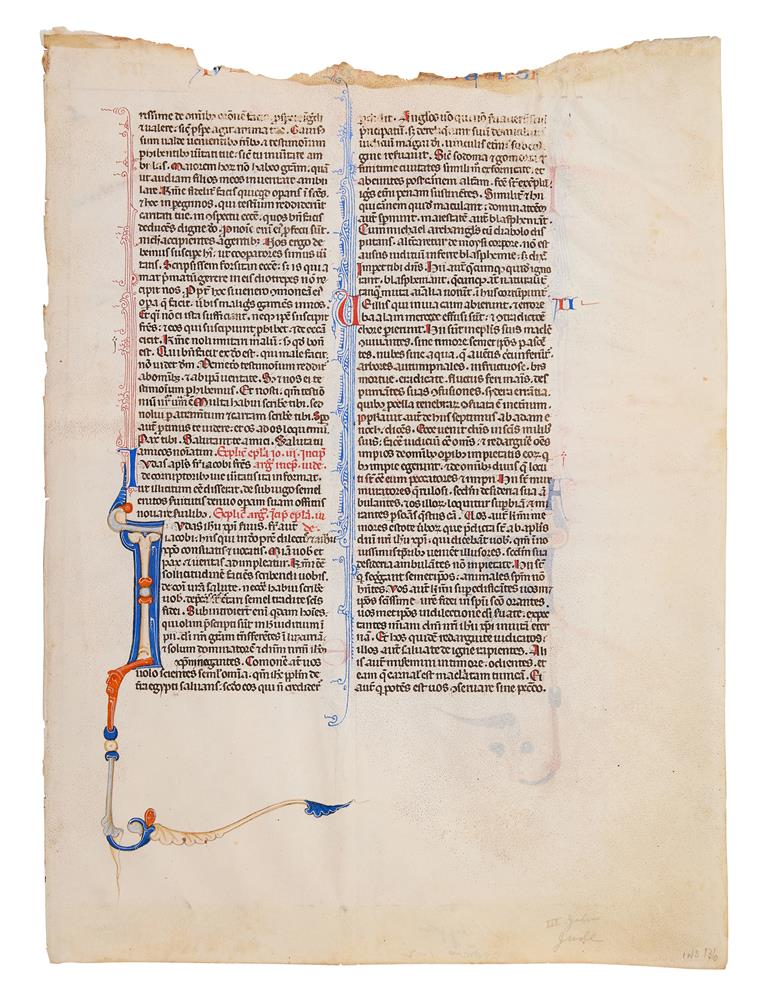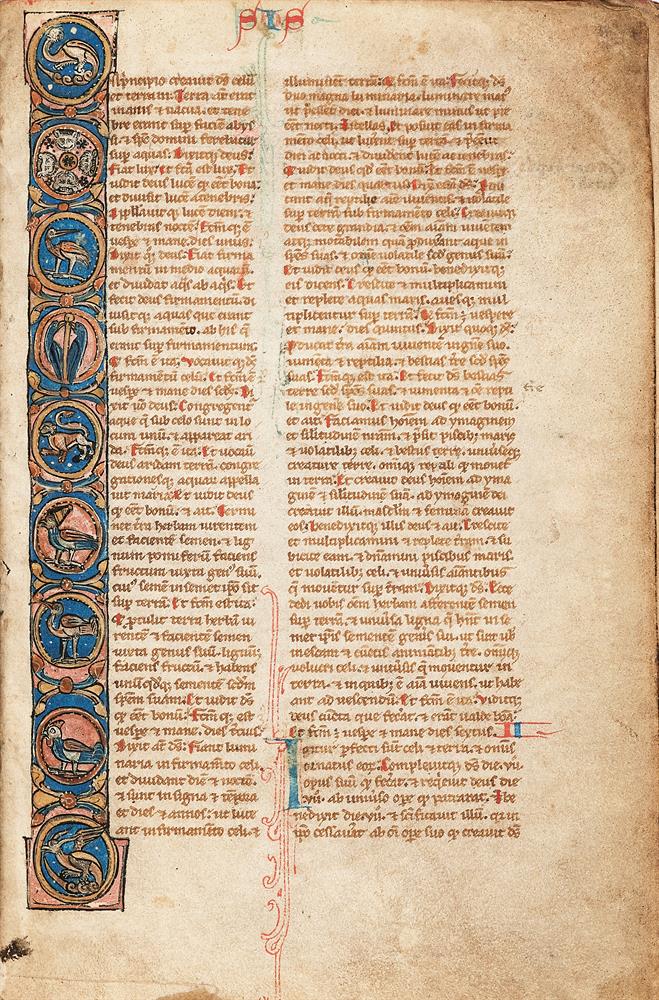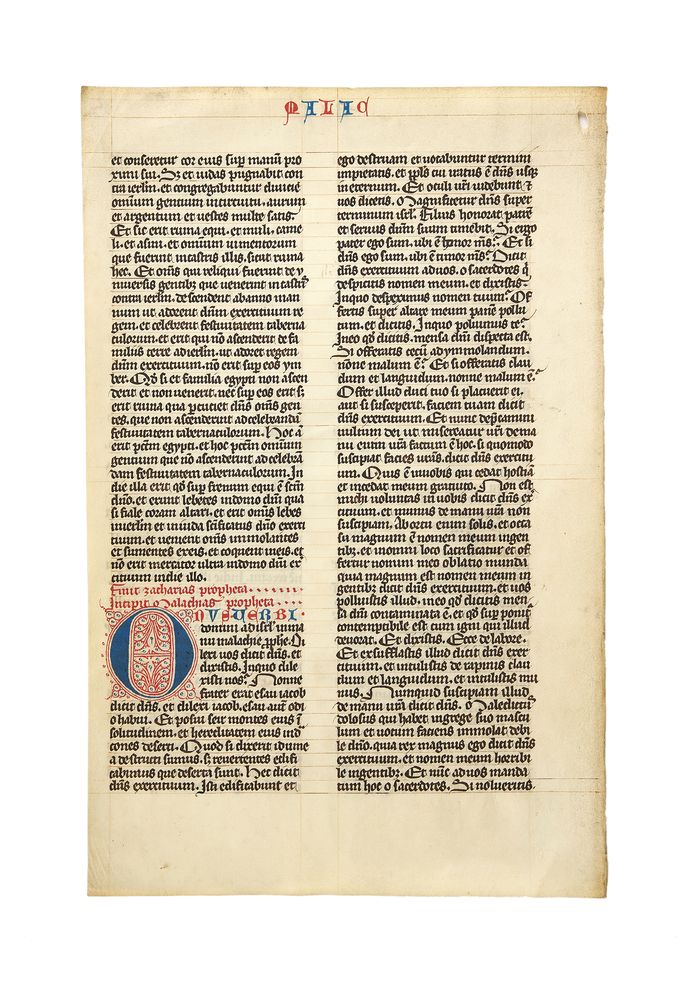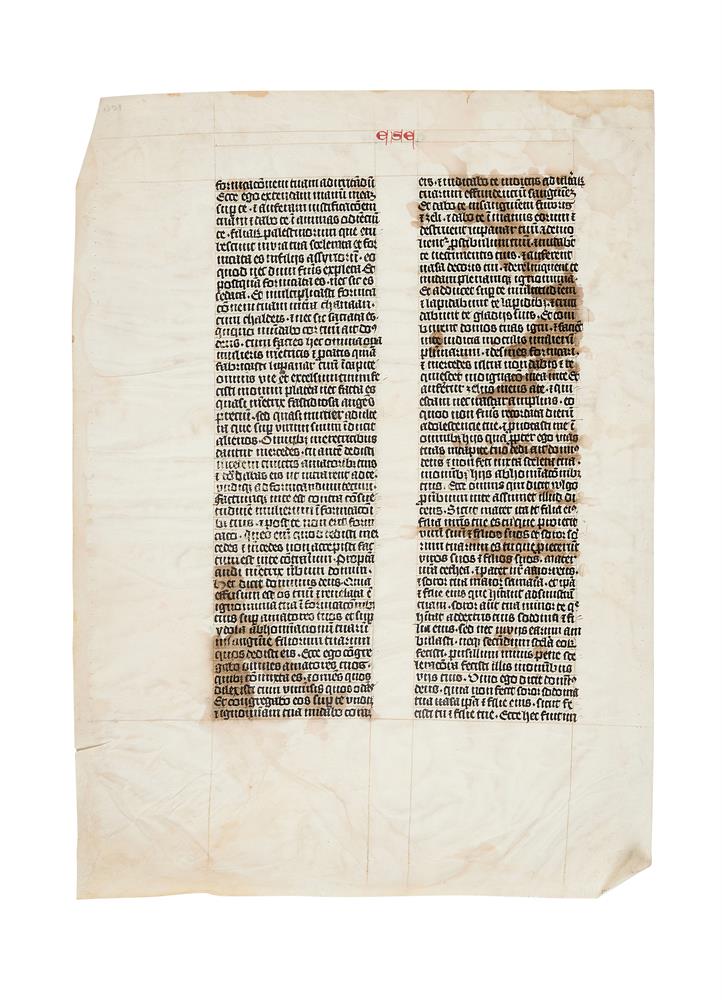BIBLE, a large decorated initial on a leaf from an Atlantic Bible, in Latin, illuminated manuscript on vellum [Italy, probably Rome, middle or third quarter 11th century] An imposing leaf from an illuminated Giant Atlantic Bible (or 'Bibbia Atlantica'). A single leaf, c.570×400mm, blind-ruled for 2 columns of 51 lines written in a good Caroline minuscule, ruled space c.420×270mm, with one rubric in Rustic Capitals, another and the incipit in Square Capitals, illuminated with a very large (16-line) initial ‘V’ filled with panels of interlace ornament, chapter divisions not originally emphasised, chapter numbers added in margins (recovered from use as a book-cover and thus with typical damage including folds and creases, a few holes and sewing punctures, the outer corners cropped, the recto with considerable wear and staining but the verso generally clean and very legible, conserved by Christopher Clarkson at West Dean College in 1989). Bound in grey buckram by Bøthuns Bokverksted, Tønsberg, Norway, 2018. Provenance : (1) Probably written and decorated at Rome, to judge by the analysis of stylistic evolution described in the introductory chapter of K. Berg, Studies in Tuscan Twelfth-Century Illumination , 1968. (2) Chapter numbers added in the margins perhaps in the 12th century (they do not correspond to the early 13th-century divisions devised by Stephen Langton, and adopted in the ‘Paris’ Bible) at Joel 2:1 and 2:28; a running heading ‘Johel p(ro)ph(et)a’ and folio number ‘cxxii’, both in red in the upper margin of the recto, perhaps added at the same time. (3) Dismembered doubtless in the mid-16th century for use as scrap vellum by a bookbinder, inscribed with a pen-trial ‘Non habui calumum scrib[ … ] melius isto’ and a series of five dates from 1550 to 1562. (4) Probably removed from a printed book in the 19th century and inscribed in pencil (partly erased) ‘[ … ] Saec. Xo’. (5) Mark Lansburgh (d.2013), teacher, hand-press printer, and manuscripts collector; not included in the 1962 Supplement to de Ricci’s Census , and thus presumably acquired at a later date. (6) Bruce Ferrini (d.2010), sold in March 1989 to: (7) Schøyen Collection, MS 216. Text : The text comprises the last two lines of a prologue (Stegmüller no 511), and Joel 1:1–3:7 (i.e. the entire book except for the last 14 verses). Jeremy Griffiths observed in 1990 that the readings in the preface ‘percipite’ for ‘percipe’, and ‘meum’ for ‘meo’, are recorded together only in one of the manuscripts collated by Donatien de Bruyne ( Pré faces de la Bible latine , 1920, p.137): St Gall, MS 44, an 8th-century copy of the biblical Prophets with an inscription by Johannes, Abbot of St Gall from 760 to 781. Script : The main text is in a fine Caroline minuscule, characterised by the use of tall ‘s’ to the exclusion of the round form, except as a majuscule at the beginning of a word, or at the end of a line; minuscule ‘f’, ‘s’, and ‘r’ which descend slightly below the other letters; ‘g’ with a closed lower bowl; ‘z’ like a large numeral ‘3’; and the absence of the ampersand and tironian nota for ‘et’. Illumination : Academic consensus has it that the phenomenon of producing large-format biblical manuscripts originated in Rome, under the papal aegis , as a means of promulgating Gregorian church reform in the 11th and 12th centuries (although for an argument as to why this theory is too reductive, see L. Yawn, ‘The Italian Giant Bible, lay patronage and professional workmanship’, Les usages sociaux de la Bible, XIe-XVe siècles , CEHTL, 3, Paris, 2010). The 'hollow shaft', 'early geometrical' style (according to the terminology of Edward B. Garrison) of the initial in the present leaf and the bright palette of reds and greens, suggests a Roman production of the second half of the 11th century. Stylistic comparisons may be drawn with a number of other central Italian Atlantic Bibles in institutional collections: Genoa, Biblioteca civica Berio, M.R. Cf 3.7; R
BIBLE, a large decorated initial on a leaf from an Atlantic Bible, in Latin, illuminated manuscript on vellum [Italy, probably Rome, middle or third quarter 11th century] An imposing leaf from an illuminated Giant Atlantic Bible (or 'Bibbia Atlantica'). A single leaf, c.570×400mm, blind-ruled for 2 columns of 51 lines written in a good Caroline minuscule, ruled space c.420×270mm, with one rubric in Rustic Capitals, another and the incipit in Square Capitals, illuminated with a very large (16-line) initial ‘V’ filled with panels of interlace ornament, chapter divisions not originally emphasised, chapter numbers added in margins (recovered from use as a book-cover and thus with typical damage including folds and creases, a few holes and sewing punctures, the outer corners cropped, the recto with considerable wear and staining but the verso generally clean and very legible, conserved by Christopher Clarkson at West Dean College in 1989). Bound in grey buckram by Bøthuns Bokverksted, Tønsberg, Norway, 2018. Provenance : (1) Probably written and decorated at Rome, to judge by the analysis of stylistic evolution described in the introductory chapter of K. Berg, Studies in Tuscan Twelfth-Century Illumination , 1968. (2) Chapter numbers added in the margins perhaps in the 12th century (they do not correspond to the early 13th-century divisions devised by Stephen Langton, and adopted in the ‘Paris’ Bible) at Joel 2:1 and 2:28; a running heading ‘Johel p(ro)ph(et)a’ and folio number ‘cxxii’, both in red in the upper margin of the recto, perhaps added at the same time. (3) Dismembered doubtless in the mid-16th century for use as scrap vellum by a bookbinder, inscribed with a pen-trial ‘Non habui calumum scrib[ … ] melius isto’ and a series of five dates from 1550 to 1562. (4) Probably removed from a printed book in the 19th century and inscribed in pencil (partly erased) ‘[ … ] Saec. Xo’. (5) Mark Lansburgh (d.2013), teacher, hand-press printer, and manuscripts collector; not included in the 1962 Supplement to de Ricci’s Census , and thus presumably acquired at a later date. (6) Bruce Ferrini (d.2010), sold in March 1989 to: (7) Schøyen Collection, MS 216. Text : The text comprises the last two lines of a prologue (Stegmüller no 511), and Joel 1:1–3:7 (i.e. the entire book except for the last 14 verses). Jeremy Griffiths observed in 1990 that the readings in the preface ‘percipite’ for ‘percipe’, and ‘meum’ for ‘meo’, are recorded together only in one of the manuscripts collated by Donatien de Bruyne ( Pré faces de la Bible latine , 1920, p.137): St Gall, MS 44, an 8th-century copy of the biblical Prophets with an inscription by Johannes, Abbot of St Gall from 760 to 781. Script : The main text is in a fine Caroline minuscule, characterised by the use of tall ‘s’ to the exclusion of the round form, except as a majuscule at the beginning of a word, or at the end of a line; minuscule ‘f’, ‘s’, and ‘r’ which descend slightly below the other letters; ‘g’ with a closed lower bowl; ‘z’ like a large numeral ‘3’; and the absence of the ampersand and tironian nota for ‘et’. Illumination : Academic consensus has it that the phenomenon of producing large-format biblical manuscripts originated in Rome, under the papal aegis , as a means of promulgating Gregorian church reform in the 11th and 12th centuries (although for an argument as to why this theory is too reductive, see L. Yawn, ‘The Italian Giant Bible, lay patronage and professional workmanship’, Les usages sociaux de la Bible, XIe-XVe siècles , CEHTL, 3, Paris, 2010). The 'hollow shaft', 'early geometrical' style (according to the terminology of Edward B. Garrison) of the initial in the present leaf and the bright palette of reds and greens, suggests a Roman production of the second half of the 11th century. Stylistic comparisons may be drawn with a number of other central Italian Atlantic Bibles in institutional collections: Genoa, Biblioteca civica Berio, M.R. Cf 3.7; R

.jpg?w=400)










.jpg)
Try LotSearch and its premium features for 7 days - without any costs!
Be notified automatically about new items in upcoming auctions.
Create an alert